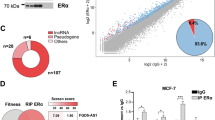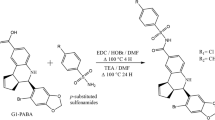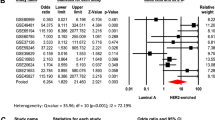Abstract
Metallothioneins (MTs), a group of ubiquitous metalloproteins, comprise isoforms encoded by ten functional genes in humans. Different MT isoforms possibly play different functional roles during development or under various physiological conditions. The MT-1E isoform mRNA has been recently shown to be differentially expressed in oestrogen receptor (OR)-positive and OR-negative breast cancer cell lines. In this study, we evaluated MT-1E mRNA expression via semi-quantitative RT-PCR in 51 primary invasive ductal breast cancer tissues, concurrently with OR-positive and progesterone receptor (PR)-positive MCF7 cells, OR-negative and PR-negative MDA-MB-231 cells and PR-transfected MDA-MB-231 breast cancer cells (ABC28). We demonstrated significantly higher MT-1E mRNA expression in OR-negative compared with OR-positive breast cancer tissues (P= 0.026). MCF7 cells lacked MT-1E mRNA expression, while both OR- and PR-negative MDA-MD-231 cells exhibited a high level of MT-1E mRNA expression. The level of MT-1E mRNA expression in progesterone-treated and -untreated ABC28 cells remained similar as the parental cell line MDA-MB-231-C2 cells. The results suggest that MT-1E may have specific and functional roles in OR-negative invasive ductal breast cancers, possibly mediated via effector genes downstream of the oestrogen receptor, but not through the PR pathway. © 2000 Cancer Research Campaign
Similar content being viewed by others
Article PDF
Change history
16 November 2011
This paper was modified 12 months after initial publication to switch to Creative Commons licence terms, as noted at publication
References
Abdel-Mageed AB and Agrawal KC (1997) Antisense down-regulation of metallothionein induces growth arrest and apoptosis in human breast carcinoma cells. Cancer Gene Ther 4: 199–207.
Andrews GK, Huet-Hudson YM, Paria BC, McMaster MT, De SK and Dey SK (1991) Metallothionein gene expression and metal regulation during preimplantation mouse embryo development (MT mRNA during early development). Dev Biol 145: 13–27.
Cavigelli M, Kagi JHR and Hunziker PE (1993) Cell- and inducer-specific accretion of human isometallothioneins. Biochem J 292: 551–554.
Celentano E, Montella M, Bonelli P, Cecco L, Marco MD, Botti G and D’Aiuto G (1998) Does a relationship exist between trends in oestrogen receptor levels and breast cancer incidence and mortality?. Int J Oncol 13: 129–135.
Dowsett M (1998) Improved prognosis for biomarkers in breast cancer. Lancet 351: 1753–1754.
Elston CW and Ellis IO (1998). Systemic Pathology, Vol 13, The Breast, 3rd edn Churchill Livingstone: Edinburgh
Fresno M, Wu W, Rodriguez JM and Nadji M (1993) Localization of metallothionein in breast carcinomas. An immunohistochemical study. Virchows Archiv A Pathol Anat Histopathol 423: 215–219.
Friedline JA, Garrett SH, Somji S, Todd JH and Sens DA (1998) Differential expression of the MT-1E gene in oestrogen-receptor-positive and -negative human breast cancer cell lines. Am J Pathol 152: 23–27.
Goulding H, Jasani B, Pereira H, Reid A, Galea M, Bell JA, Elston CW, Robertson JF, Blamey RW, Nicholson RA, Schmid KW and Ellis IO (1995) Metallothionein expression in human breast cancer. Br J Cancer 72: 968–972.
Haerslev T, Jacobsen GK and Zedeler, (1995) The prognostic significance of immunohistochemically detectable metallothionein in primary breast carcinomas. APMIS 103: 279–285.
Jahroudi N, Foster R, Price-Haughey J, Beitel G and Gedamu L (1990) Cell-type specific and differential regulation of the human metallothionein genes. J Biol Chem 265: 6506–6511.
Jasani B, Campbell F, Navabi H, Schmid KW and Williams GT (1998) Clonal overexpression of metallothionein is induced by somatic mutation in morphologically normal colonic mucosa. J Pathol 184: 144–147.
Jayasurya A, Bay BH, Yap WM and Tan NG (2000) Correlation of metallothionein expression with apoptosis in nasopharyngeal carcinoma. Br J Cancer 82: 1198–1203.
Jin R, Bay B, Tan P and Tan BK (1999) Metallothionein expression and zinc levels in invasive ductal breast carcinoma. Oncol Rep 6: 871–875.
Kagi JHR and Schaffer A (1988) Biochemistry of metallothionein. Biochemistry 27: 8509–8515.
Kagi JHR (1991) Overview of metallothioneins. Methods Enzymol 205: 613–626.
Karin M, Eddy RL, Henry WM, Haley LL, Byers MG and Shows TB (1984) Human metallothionein genes are clustered on chromosome 16. Proc Natl Acad Sci USA 81: 5494–5498.
Kondo Y, Kuo SM, Watkins SC and Lazo JS (1995) Metallothionein localization and cisplatin resistance in human hormone-independent prostatic tumour cell lines. Cancer Res 55: 474–477.
Lin VCL, Ng EH, Aw SE, Tan MGK, Ng EHL, Chan VSW and Ho GH (1999) Progestins inhibit the growth of MDA-MB-231 cells transfected with progesterone receptor complementary DNA. Clin Cancer Res 5: 395–403.
Lin VCL, Ng EH, Aw SE, Tan MGK, Ng EHL and Bay BH (2000) Progesterone induces focal adhesion in breast cancer cells MDA-MB-231 transfected with progesterone receptor cDNA. Mol Endocrinol 14: 348–358.
Lohrer H and Robson T (1989) Overexpression of metallothionein in CHO cells and its effect on cell killing by ionizing radiation and alkylating agents. Carcinogenesis 10: 2279–2284.
McCluggage WG, Maxwell P, Hamilton PW and Jasani B (1999) High metallothionein expression is associated with features predictive of aggrfessive behaviour in endometrial carcinoma. Histopathology 34: 51–55.
Mckenzie K and Sukumar S (1996) Molecular genetics of human breast cancer. Cellular and Molecular Mechanisms of Hormonal Carcinogenesis Huff J, Boyd J, Barrett J C (eds) pp 183–209, Wiley-Liss: New York
Mididoddi S, McGuirt JP, Sens MA, Todd JH and Sens DA (1996) Isoform-specific expression of metallothionein mRNA in the developing and adult human kidney. Toxicol Lett 685: 17–27.
Murphy LC, Dotzlaw H, Leygue E, Coutts A and Watson P (1998) The pathophysiological role of oestrogen receptor variants in human breast cancer. J Steroid Biochem Molec Biol 65: 175–180.
Palmiter RD, Findley SD, Whitmore TE and Durnam DM (1992) MT-III, a brain-specific member of the metallothionein gene family. Proc Natl Acad Sci USA 89: 6333–6337.
Quaife CJ, Findley SD, Erickson JC, Froelick GJ, Kelly EJ, Zambrowicz BP and Palmiter RD (1994) Induction of a new metallothionein isoform (MT-IV) occurs during differentiation of stratified squamous epithelia. Biochemistry 33: 7250–7259.
Rayter Z (1991) Steroid receptors in breast cancer. Br J Surg 78: 528–535.
Richards RI, Heguy A and Karin M (1984) Structural and functional analysis of the human metallothionein-1A gene: differential induction by metal ions and glucocorticoids. Cell 37: 263–272.
Rich MA, Furmanski P and Brooks SC (1978) Prognostic value of oestrogen receptor determinations in patients with breast cancer. Cancer Res 38: 4296–4298.
Schmid KW, Ellis IO, Gee JMW, Darke BM, Lees WE, Kay J, Cryer A, Stark JM, Hittmair A, Ofner Dunser M, Margreiter R, Daxenhichler G, Nicholson RI, Bier B, Bocker W and Jasani B (1993) Presence and possible significance of immunocytochemically demonstrable metallothionein over-expression in primary invasive ductal carcinoma of the breast. Virchows Archiv A Pathol Anat Histopathol 422: 153–159.
Schmidt CJ and Hamer DH (1986) Cell specificity and an effect of ras on human metallothionein gene expression. Proc Natl Acad Sci USA 83: 3346–3350.
Stennard FA, Holloway AF, Hamilton J and West AK (1994) Characterization of six additional human metallothionein genes. Biochim Biophys Acta 1218: 357–365.
West AK, Stallings R, Hildebrand CE, Chiu R, Karin M and Richards RI (1990) Human metallothionein genes: structure of the functional locus at 16q13. Genomics 8: 513–518.
Wittliff JL, Pasic R and Bland KI (1998) Steroid and peptide hormone receptors: methods, quality control and clinical use. The Breast 1: Bland K I, Copeland E M (eds) pp 458–498, WB Saunders Co: Philadelphia
Yang YY, Woo ES, Reese CE, Bahnson RR, Saijo N and Lazo JS (1994) Human metallothionein isoform gene expression in cisplatin-sensitive and resistant cells. Mol Pharmacol 45: 453–460.
Author information
Authors and Affiliations
Rights and permissions
From twelve months after its original publication, this work is licensed under the Creative Commons Attribution-NonCommercial-Share Alike 3.0 Unported License. To view a copy of this license, visit http://creativecommons.org/licenses/by-nc-sa/3.0/
About this article
Cite this article
Jin, R., Bay, B., Chow, V. et al. Metallothionein 1E mRNA is highly expressed in oestrogen receptor-negative human invasive ductal breast cancer. Br J Cancer 83, 319–323 (2000). https://doi.org/10.1054/bjoc.2000.1276
Received:
Revised:
Accepted:
Published:
Issue date:
DOI: https://doi.org/10.1054/bjoc.2000.1276
Keywords
This article is cited by
-
The roles of metallothioneins in carcinogenesis
Journal of Hematology & Oncology (2018)
-
The unique C- and N-terminal sequences of Metallothionein isoform 3 mediate growth inhibition and Vectorial active transport in MCF-7 cells
BMC Cancer (2017)
-
Expression of metallothionein protein relating to proliferative cell index in malignant feline mammary tumors using high throughput tissue microarray technique
Comparative Clinical Pathology (2016)
-
Overlapping gene expression profiles of cell migration and tumor invasion in human bladder cancer identify metallothionein 1E and nicotinamide N-methyltransferase as novel regulators of cell migration
Oncogene (2008)
-
Clinicopathological significance of metallothioneins in breast cancer
Pathology & Oncology Research (2004)



